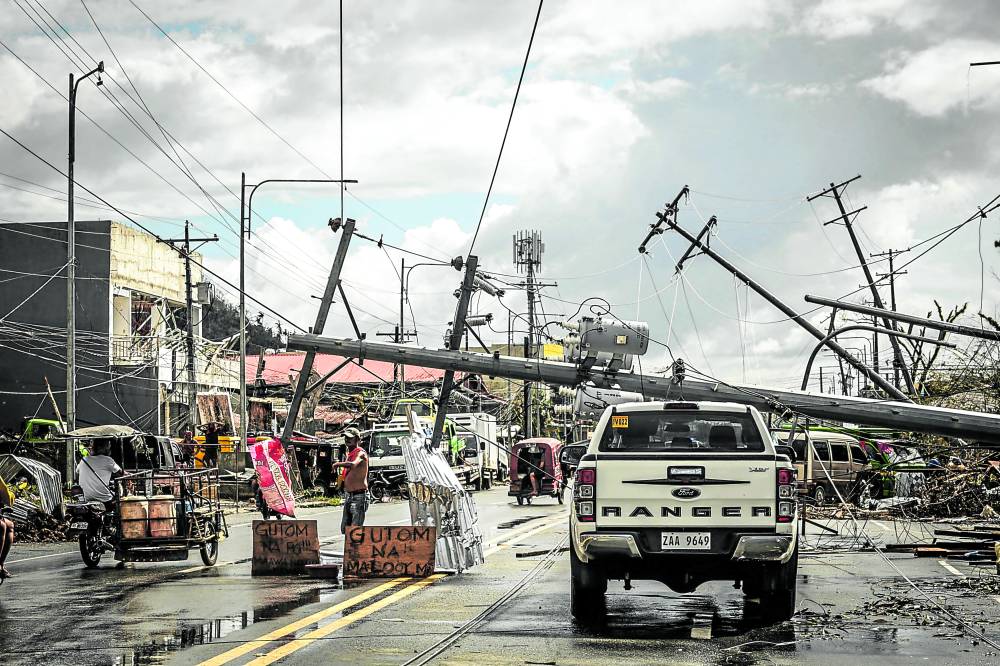They prepared for Signal No. 3, but proved wrong about ‘Odette’

UNEXPECTED FURY Fallen electric posts are still blocking a major road in Surigao City, Surigao del Norte province, in this photo taken on Dec. 19, four days after the onslaught of Typhoon “Odette.” —AFP
SURIGAO CITY—Local government officials here thought they had prepared sufficiently for Typhoon “Odette” (international name: Rai), but it turned out they were clueless of its strength.
Per the account of city administrator Jerry Centro, the local government had evacuated 5,963 families before Odette’s landfall on Dec. 16. Mayor Ernesto Matugas Jr. issued an order for preemptive evacuation as early as Dec. 15, and by nightfall of that day, some 3,280 families had been moved from areas prone to flood, landslide, and storm surge and sheltered in 48 centers.
“We told the people that if they didn’t evacuate that day (Dec. 15), we may never be able to respond to their distress call at the height of the typhoon as that would [endanger] the lives of our rescuers,” Centro told the Inquirer.
He said the approach they used was successful in convincing the families to leave their homes temporarily, and more families streamed to the evacuation centers in the morning of Dec. 16.
Had the preemptive-evacuation effort faltered, there would have been more deaths during the storm as most of the houses vacated by the families on Dec. 15 were destroyed, Centro said.
Article continues after this advertisementThese were houses made of light materials, and were mostly in the coastal villages.
Article continues after this advertisement5 deaths
The local government has so far recorded five residents dead, four of whom were struck by flying roof sheets and posts and trusses as these crumbled under Odette’s fierce winds.
Earlier, Mayor Matugas told a local radio station that the city government had initially estimated 5,000 families to be potentially affected by the typhoon, based on the warnings of the weather bureau Pagasa (or the Philippine Atmospheric, Geophysical and Astronomical Services Administration).
“Our preparation was for Signal No. 3, per advisory from Pagasa,” Matugas said. He said that he was not blaming the weather forecasters, and that the massive destruction was “inevitable” given the typhoon’s strength.
Constant warnings
“We were able to prepare. But no matter how much we prepared, we could not prevent the damage,” he added.
Before Odette barreled in, the city’s public information office (PIO) was constantly posting weather updates and warnings on social media.
At around 9 a.m. of Dec. 16, the PIO advised residents to stock up on food and water, charge their gadgets, and be ready with flashlights as the typhoon could cause an interruption in the power supply.
It subsequently repeated a warning of heavy rainfall, strong winds, storm surge and flood.
At 2 p.m. on that day, the PIO posted an advisory that the city had been placed under Storm Signal No. 4, along with a brief video of huge waves pummeling the seawall at Luneta Park.
It urged everyone not to venture outside their homes.
City residents told the Inquirer that while they were accustomed to the passage of typhoons, it was their first time to experience one so violent.
11 regions
Elders in the communities said their memory of a storm comparable to Odette’s strength was Typhoon “Nitang,” which ravaged Surigao del Norte in 1984.
Over 2 million people were affected by Odette in 11 regions, mostly in the Visayas, where it ravaged some P3.6 billion worth of agriculture and infrastructure.
The National Disaster Risk Reduction and Management Council (NDRRMC) on Thursday placed the total population affected by Odette at nearly 2.2 million in 4,566 barangays across Mimaropa, Bicol, Western Visayas, Central Visayas, Eastern Visayas, Zamboanga Peninsula, Northern Mindanao, Davao region, Soccsksargen, Caraga and the Bangsamoro Autonomous Region in Muslim Mindanao.
Of that number, some 609,000 people were displaced, some of whom remain in 2,500 evacuation centers across the affected regions.
The NDRRMC estimated the total damage to agriculture caused by Odette at P1.15 billion and to infrastructure at P2.54 billion.
Damage to agriculture was worst in the Eastern Visayas at P239.3 million, and in Mimaropa at P151 million. The other regions that reported extensive damage to agriculture were Calabarzon, Bicol, Central Visayas, Northern Mindanao, the Davao region and Caraga.
In terms of infrastructure, Central Visayas was hardest hit, with the damage to private and public facilities placed at P2.155 billion. Damage to infrastructure was also extensive in Mimaropa, Eastern Visayas, Northern Mindanao and Caraga.
On Thursday, the NDRRMC said the number of reported deaths had reached 258. It said 47 persons remained missing and 568 others had been reported injured.
The 258 reported fatalities were spread out in the provinces: 96 in Bohol, 66 in Negros Oriental, 58 in Cebu, 21 in Surigao del Norte, four each in Misamis Oriental and Agusan del Sur, two each in Palawan and Guimaras, a fatality each in Iloilo, Negros Occidental, Bukidnon and Misamis Occidental, and another in Butuan City.
According to the NDRRMC, 47 persons were reported missing in Cebu, Bohol, Palawan, Agusan del Sur, and Negros Oriental. —With a report from Jeannette I. Andrade